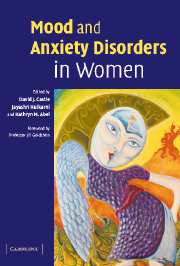Book contents
- Frontmatter
- Contents
- Contributors
- Preface
- Foreword
- 1 Pubertal development and the emergence of the gender gap in mood disorders: A developmental and evolutionary synthesis
- 2 Borderline personality disorder: Sex differences
- 3 Substance use and abuse in women
- 4 Anxiety disorders in women
- 5 Posttraumatic stress disorder in women
- 6 Domestic violence and its impact on mood disorder in women: Implications for mental health workers
- 7 Depression in women: Hormonal influences
- 8 Anxiety and mood disorders in pregnancy and the postpartum period
- 9 Pharmacological treatment of anxiety and depression in pregnancy and lactation
- 10 Bipolar affective disorder: Special issues for women
- 11 Mood and menopause
- 12 Anxiety and depression in women in old age
- Index
6 - Domestic violence and its impact on mood disorder in women: Implications for mental health workers
Published online by Cambridge University Press: 13 August 2009
- Frontmatter
- Contents
- Contributors
- Preface
- Foreword
- 1 Pubertal development and the emergence of the gender gap in mood disorders: A developmental and evolutionary synthesis
- 2 Borderline personality disorder: Sex differences
- 3 Substance use and abuse in women
- 4 Anxiety disorders in women
- 5 Posttraumatic stress disorder in women
- 6 Domestic violence and its impact on mood disorder in women: Implications for mental health workers
- 7 Depression in women: Hormonal influences
- 8 Anxiety and mood disorders in pregnancy and the postpartum period
- 9 Pharmacological treatment of anxiety and depression in pregnancy and lactation
- 10 Bipolar affective disorder: Special issues for women
- 11 Mood and menopause
- 12 Anxiety and depression in women in old age
- Index
Summary
Physical, emotional, and sexual abuse of women by an intimate partner is strongly associated with depression, anxiety and anxiety disorders, and a variety of other psychiatric problems, including substance abuse, dissociation and dissociative disorders, and post-traumatic stress disorder (PTSD). Intimate partner violence, or domestic violence, affects an estimated one in four women and, along with depression, has been recognised by the World Health Organisation (1998) to be a significant public health concern. Domestic violence also affects children, who may themselves be subject to abuse and/or witness the violence. Both girl and boy child victims of abuse have significantly higher rates of childhood mental disorders, anxiety disorders, personality disorders and major affective disorders, and witnessing violence as a child has particularly been associated with anxiety in girls (Spataro et al., 2004). Despite the recognition that domestic violence is a major risk factor for depression and that depression adds significantly to the global burden of disease for women (Ustun et al., 2004), to date detailed exploration of possible causes and systematic studies of interventions are lacking. Depression is commonly treated without knowledge of the context of violence in which it might occur. If mental health professionals placed more emphasis on the experience of violence as a cause of depression and anxiety, some of this burden might be reduced. In this chapter we (1) define domestic violence, (2) consider its mental health outcomes, (3) highlight barriers that might prevent health professionals' adequate assessment of the problem, and (4) suggest possible solutions.
- Type
- Chapter
- Information
- Mood and Anxiety Disorders in Women , pp. 92 - 115Publisher: Cambridge University PressPrint publication year: 2006
- 2
- Cited by

